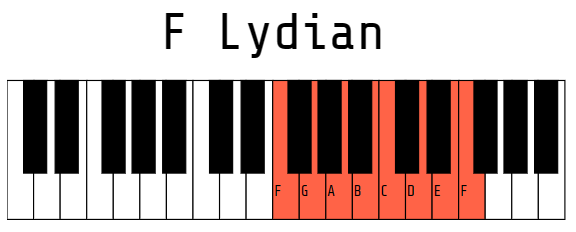Lydian scale (Lydian mode)
Lydian Mode Scale
The Lydian mode is a musical scale that is often associated with a major sound but has a unique characteristic: a raised fourth degree.
The formula for the Lydian mode scale is: T - T - T - S - T - T - S
- Start on any note (tonic)
- Move up a whole step (T)
- Move up a whole step (T)
- Move up a whole step (T)
- Move up a half step (S)
- Move up a whole step (T)
- Move up a whole step (T)
- Move up a half step (S)
For example, if we start on the note F, applying the formula gives us the F Lydian mode scale:
- F - G - A - B - C - D - E - F
The Lydian mode is often used in jazz, fusion, and various other genres. It has a distinct sound and is characterized by its raised fourth degree, which gives it a bright and colorful feel.

Lydian Mode Characteristics
The Lydian mode is a unique scale that stands out due to its distinctive interval pattern and the particular mood it creates.
Here are a few key aspects that make the Lydian mode special and differentiate it from other scales:
- Raised 4th Degree: The Lydian mode is characterized by its raised fourth degree, giving it a distinct and bright quality.
- Majestic Sound: The Lydian mode is often associated with a major tonality due to its major third and major seventh.
- Ethereal and Dreamy: The Lydian mode has an ethereal and dreamy sound, often used to create a sense of wonder or mystery in music.
- Rich Harmonic Possibilities: The interval pattern of the Lydian mode allows for interesting chord progressions and harmonizations, offering a wide range of tonal possibilities.
- Film and Game Music: The Lydian mode is frequently used in film and game soundtracks to evoke a sense of adventure, magic, or otherworldliness.
Overall, the Lydian mode's unique qualities make it a favorite among musicians and composers seeking to explore different tonal flavors and create captivating musical atmospheres.
Famous Songs in Lydian Mode
Here are a few examples of famous songs that utilize the Lydian mode:
- "The Simpsons Theme" - Danny Elfman
- "Yoda's Theme - Empire Strikes Back" - John Williams
- "Waltz #1" - Elliot Smith
- "Spain" - Chick Corea
- "Man On The Moon" - R.E.M.
- "Theme from Back To The Future" - Alan Silvestri
- "Theme from E.T.: The Extra Terrestrial" - John Williams
These songs incorporate elements of the Lydian mode either in their melodies, chord progressions, or improvisations. They showcase the unique and captivating qualities of the Lydian mode in various musical contexts.
Keep in mind that the Lydian mode might be present in certain sections of these songs or used as a basis for improvisation, rather than being the entire composition.
Chords in F Lydian Mode
Triads:
- F (F major): F - A - C
- G (G major): G - B - D
- Am (A minor): A - C - E
- Bdim (B diminished): B - D - F
- C (C major): C - E - G
- Dm (D minor): D - F - A
- Em (E minor): E - G - B
Quadriads:
- Fmaj7 (F major 7): F - A - C - E
- G7 (G dominant 7): G - B - D - F
- Am7 (A minor 7): A - C - E - G
- Bm7b5 (B half-diminished 7): B - D - F - A
- Cmaj7 (C major 7): C - E - G - B
- Dm7 (D minor 7): D - F - A - C
- Em7 (E minor 7): E - G - B - D
These chords are derived by stacking thirds (either major or minor) on each degree of the F Lydian mode. The resulting triads consist of three notes, while the quadriads consist of four notes.
Feel free to experiment with these chords to create chord progressions or use them as a starting point for your musical compositions.